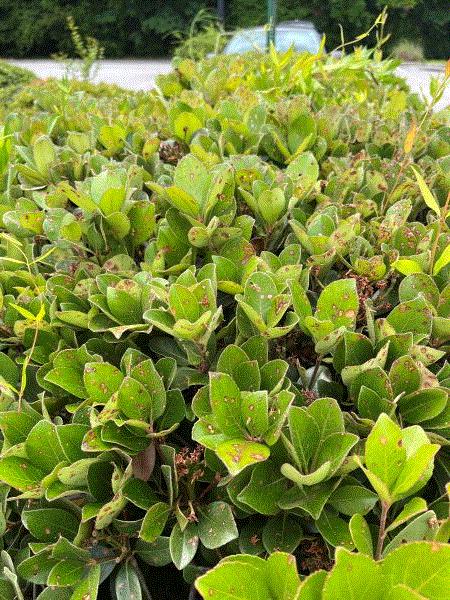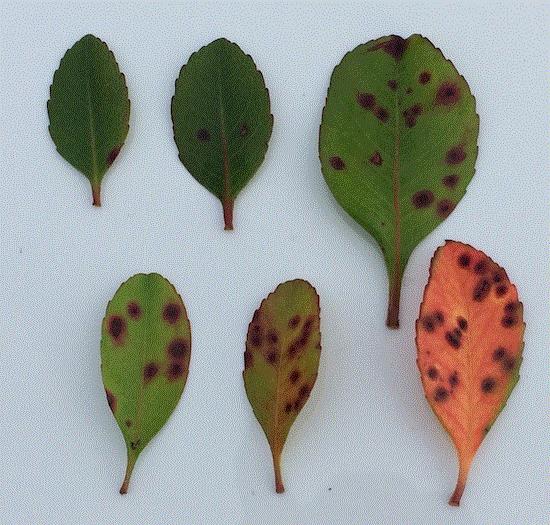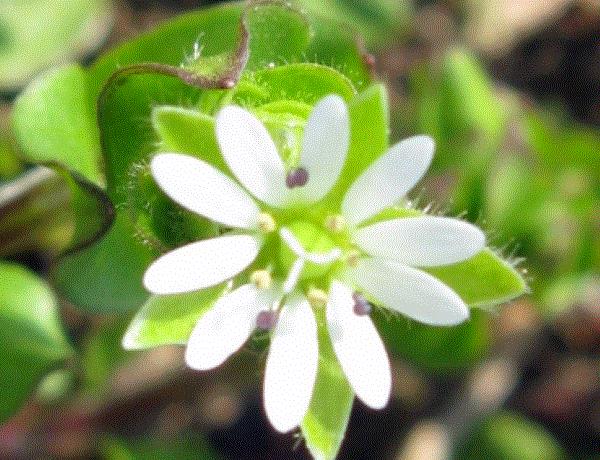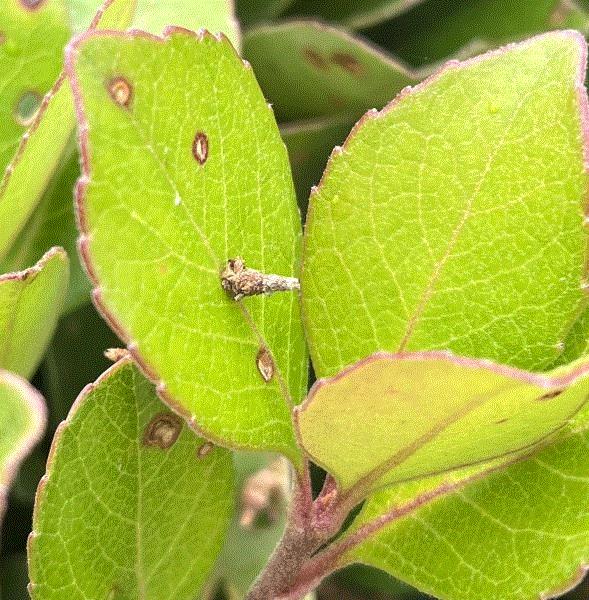What the ... ?
When my wife and her dog aren't home, I shop at a country grocery store 4 miles down the road instead of the fancier ones in the city of Florence, South Carolina. It isn’t because the country grocery store has cheaper beer and ice cream. The main reason is that the townie grocery stores are more than 10 miles away. (I know, I’m such a homebody. But please have some empathy for my anxiety when I see more than three cars in front of me in traffic!)
Another reason is that I can find all sorts of pests and diseases on the shrubs “minimally” maintained by the local landscape care operation that the store manager hired. The site has contributed pictures of the damage by rose rosette disease, caterpillars and scale insects (to name a few) to this newsletter.

I found something interesting on the Indian hawthorn. (I’m calling them Indian hawthorn knowing full well that the horticultural varieties have some murky taxonomic issues. I can’t tell one species or hybrid from another, so please excuse my relative liberal attitude towards the plant’s taxonomy.) From a distance, it looks like a bunch of shotholes on the new leaves.
What could it be ...?

Diseases of Indian Hawthorn
Indian hawthorn is a relatively pest- and disease-free plant, in my opinion. You’d think that being such a tough plant, Indian hawthorn should be planted everywhere. But, no, I must go some distance before I’ll see another Indian hawthorn bush, which often aren’t in the best shape.
Some old-timers can testify to Indian hawthorn’s popularity at one point in time. Even though it’s relatively problem-free there's one disease that single-handedly relegated Indian hawthorn to obscurity—Entomosporium leaf spot. Aphids, scale insects, fire blight, etc. can’t hold a candle to what this disease can do.
Entomosporium leaf spot on Indian hawthorn, which is caused by the fungus Entomosporium mespili (AKA Diplocarpon mespili), also affects photinia. Symptoms of this disease appear as reddish leaf spots surrounded by dark red or purple halos. Sporulation occurs in the center of the leaf spots, which gives them a grayish look. Leaf chlorosis and defoliation occurs as the disease progresses. A heavily infested bush can look rather thin and unthrifty. Most Indian hawthorn bushes I see in the South don’t appear healthy because of this disease.

Some India hawthorn varieties and hybrids are resistant to Entomosporium leaf spot. Go HERE for more information about this disease and disease-resistant varieties. Cultural control-wise, collecting and removing infected leaves from under the bush and avoiding water splashing when irrigating (particularly when new leaves are flushing) are often recommended.
Many fungicides are registered for managing Entomosporium leaf spot. Many of these are in the FRAC Group 3, 11, M1 and M5. Researchers working with the IR-4 Environmental Horticulture Program had identified azoxystrobin, chlorothalonil, copper, mycobutanil, propiconazole, tebuconazole, thiophanate methyl and trifloxystrobin as being good to excellent against Entomosporium mespili. (Go HERE for a copy of the IR-4 efficacy summary for leaf spots and anthracnose.) The key to successful management is to make applications to protect new growth (i.e. as preventive control).

Common Chickweed in Containers
Debalina Saha and Carolyn Fitzgibbon of Michigan State University talked about common chickweed, specifically in the context of greenhouse production, in a recent issue of e-GRO Alert. Go HERE for the article.
I’m quite familiar with common chickweed. This is one of the most common winter annual weed I come across in outdoor container and field production in the South. I know that my mother-in-law’s goats love this stuff and it’s everywhere in this country. What I didn’t know is that chickweed is an introduced species from Eurasia and North Africa.
I was curious when the introduction to North America occurred. I found that it was recorded in 1873 in Canada and 1930 in Hawaii, but not a whole lot of information on the year of introduction in other places. (Okay, Hawaii may not be geographically North America, but it’s politically part of Nort America. I’m being a bit loose in my geography here.)
Interestingly, during the research, I found an article published in 1979 by Suzanne W. Batra in the Journal of the New York Entomological Society (Volume 87, Issue 3, page 223-235) outlining 156 species of herbivorous and pollinating insects, and three herbivorous mites that had been found on the common chickweed (Stellaria media) and the stitchwort (Stellaria graminea). (Dr. Batra graduated with a Ph.D. from the University of Kansas. She retired from USDA, but continues to work on bees at the Smithsonian Institution. She received the Saranac Lake Distinguished Alumni Award in 2024.)

Here's a good characteristic to identify chickweed: This flower has five white petals that are deeply lobed, which make them look like 10 petals. (Photo credit: Michigan State University, Plant and Pest Diagnostics.)
Back to Debalina and Carolyn’s article ... They described the appearance of chickweed to help you identify it. They also talked about how to manage chickweed in greenhouses. Cultural control is prominent because herbicide options in greenhouses are limited (flumioxazin, indaziflam and pelargonic acid are mentioned). Hand-weeding should be done frequently (every two to three weeks) and before weeds flower and seed. Organic mulch (1- to 2-in. deep) may also prevent weed germination.
For folks interested in managing (common and mouseear) chickweed in container nurseries, I recommend a guide on preemergence herbicide efficacy by Joe Neal (North Carolina State University), Jeff Derr (Virginia Tech), Chris Marble (University of Florida) and Andrew Senesac (Cornell Cooperative Extension; retired). The guide was updated in 2021 and listed the efficacy of many preemergence herbicides in controlling a wide range of weeds. Based on the guide, it seems to me that most preemergence herbicides are effective in managing chickweed if applications are made in the fall before the seeds germinate.

Register Today for the 2025 International Plant Trialing Conference
The next piece of news comes from our own Jen Zurko:

Late last year, All-America Selections (AAS) announced that it was resurrecting the International Plant Trialing Conference in 2025 after a decade-long hiatus and registration is open for those interested in attending.
Planned for October 13-15 at the Embassy Suites Hotel in Bloomington, Minnesota, this educational conference will include sessions covering a wide range of topics, including ornamentals, finished and CEA edibles (for the first time at this conference), plant trialing techniques and industry trends. All of the sessions will be presented in panel discussion form, which will allow for attendees to hear diverse perspectives and insights from multiple trialing experts—it’s won’t just be one person presenting on a topic.
Diane Blazek, Executive Director of AAS, made a point to say that, historically, the International Plant Trialing Conference has never been an annual event and their goal is not to make it so. It’s a special event that will be held every few years, although Diane said she’s not sure yet when the next one will be. So that’s a big reason why she encourages breeders, growers, trials managers and other industry professionals to take advantage of the opportunity to attend. This conference will also be serving double duty, as many of the activities that typically happen at the AAS Summer Summit will take place during the event, as well.
Lunch is included with the registration for the two full days of sessions and, if you’re interested, you can extend your stay either before or after the conference to visit Bailey Nurseries and/or the University of Minnesota arboretum and flower trials. (You have to schedule these on your own.)
Early bird registration pricing ends August 1, so for session topics, and to register and reserve your hotel, go HERE.

Answer to "What the ... ?"
Initially, I thought the shotholes on Indian hawthorn bushes were caused by some shothole disease. Upon closer examination, I found the bushes covered with small bagworms. Judging by their size, these bagworms were still rather young and highly susceptible to insecticides.
Although bagworms are often associated with junipers and arborvitae, Indian hawthorn and several broadleaf shrub and tree species are known hosts. There are 28 bagworm species in North America and often it’s extremely difficult to identify species based on the sizes and characteristics of the bags. That’s because bagworms aren’t picky about what they use to cover their bags, so appearances of a species can vary greatly depending on hosts. All of this is to say that I’m not certain what this species is.

Most species have only one generation per year. Only males grow into moths, which fly around and look for mates using pheromones released by the females. Adult females have greatly reduced wings when mature. They remain in their pupal cases inside the bags. The males must crawl into the bags and mate with the females. The females then lay eggs inside the pupal case. When the eggs hatch in the spring, the young caterpillars emerge out of their mothers’ pupal cases and bags, and disperse to other parts of the same plant or ballon to another plant by catching the wind with silken threads they produce.
Predators and parasitoids keep the bagworm population under control during most years. Bagworm populations can get out of control when natural control is disrupted. This is when insecticides may be needed. Bacillus thuringiensis subspecies kurstaki (such as Dipel) is effective and conventional insecticides (such as spinosad, carbaryl, chlorantraniliprole and pyrethroids) are effective. The efficacy of these products is higher when used against hatchlings and young bagworms, so application timing is crucial.
How do you know when eggs hatch? I suggest that you pick a few bags in April, put them in a loosely closed or screened glass jar (or any transparent container), keep the jar in the shade (make sure the jar isn’t exposed to heat or direct sunlight), and check on the jar for tiny worms around May (they won't have bags since they haven't fed yet). You can start spraying a week or two after seeing the tiny worms.




See y'all later!

JC Chong
Technical Development Manager at SePRO
Adjunct Professor at Clemson University
This e-mail received by 27,847 subscribers like you!
If you're interested in advertising on PestTalks contact Kim Brown ASAP!